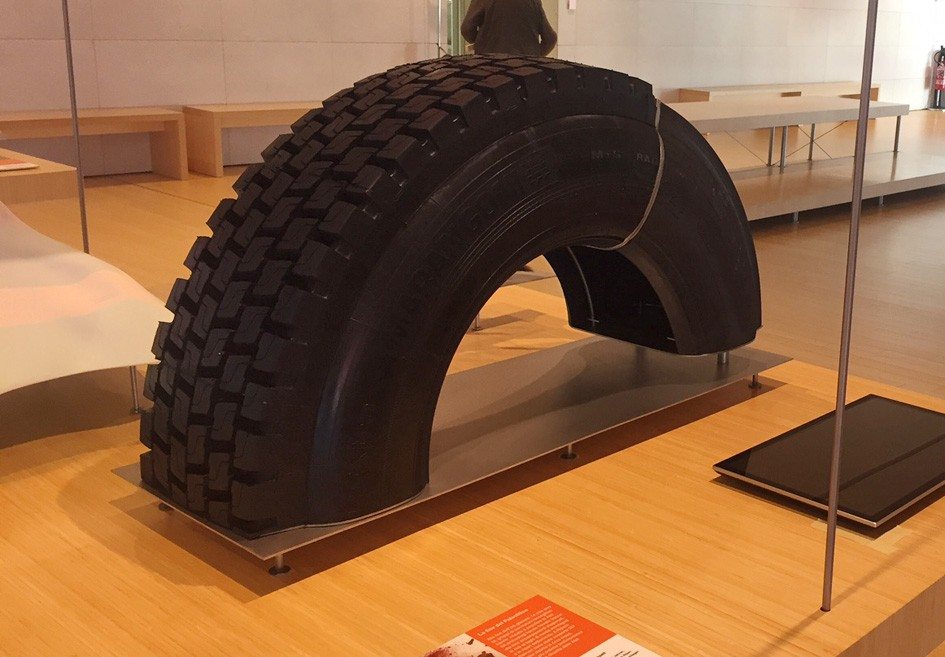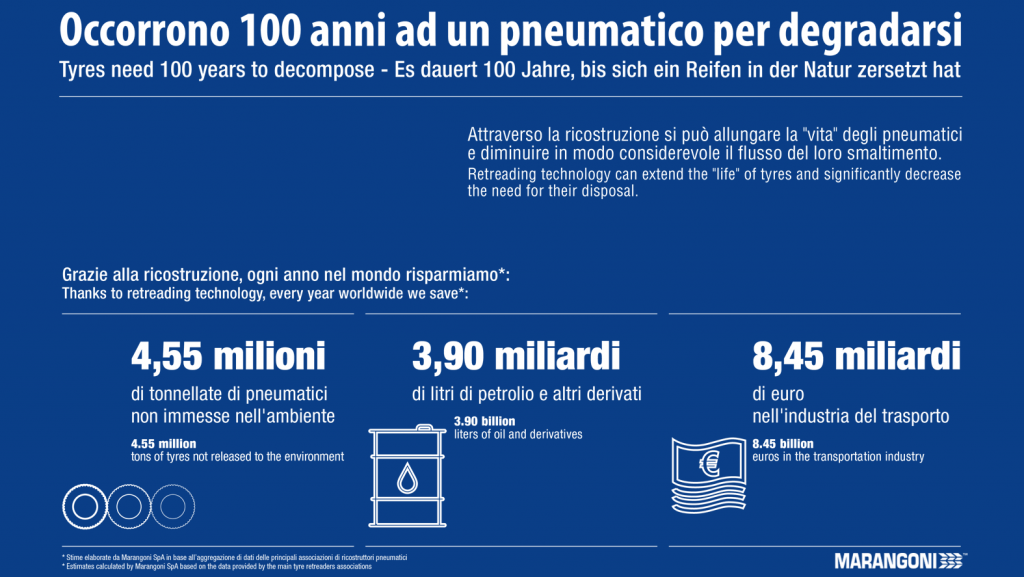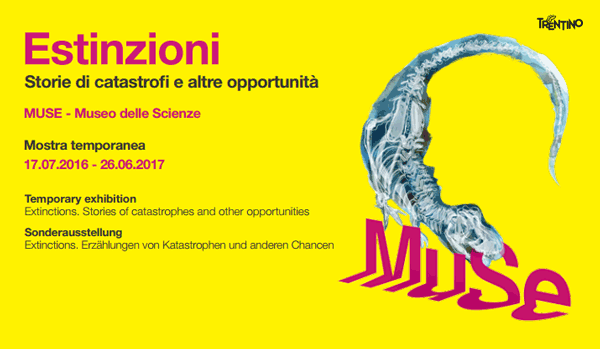
22 May The evolution of the species against the dinosaurs of waste
The Marangoni Group and the Muse Science Museum: a rather unexpected partnership. The occasion is the exhibition “Extinctions. Stories of catastrophes and other opportunities”, now held at the museum in Trento until 26 June. Why we decided to support this initiative? Because we are experiencing a new era, to say it in the terms used by Muse: in fact, we are in the midst of a transition from a linear economy to a circular economy, to a more efficient use of the resources of our planet. This is the key transformation that is currently affecting production and consumption patterns worldwide. It is a historical phase in which terms such as “extinction”, in fact, or “catastrophes and opportunities” seem to be quite fitting. And they can be used equally well to take into account some of the transformations that, today, are affecting tyre production and, as a result, also our Group.
The exhibition leaflet
The circular economy is – to use the definition given by the Ellen MacArthur Foundation – “an economy designed to regenerate itself“. It is a system in which all activities, starting from extraction and production, are organised so that someone’s waste becomes a resource for someone else.
Until 2012, there were no studies on the value of the introduction of the circular flow model in the real economy. The first report published on the subject is “Towards the circular economy“, which was presented only five years ago by the Ellen MacArthur Foundation. The study shows how the circular economy offers potential savings of more than 600 billion euros a year starting in 2025, taking into account the time for full introduction. Another authoritative source, i.e. McKinsey, estimates a growth of 11% of the European GDP by 2030 and a 48% reduction in emissions through scalar growth of the circular economy over the next five years.
Today, in the tyre industry, we can identify many of the typical features of the linear model in the imports of products made in Asia, as opposed to the circular model based on retreadable products.
Video made for the partnership with MUSE
It is a contrast that we experience daily at Marangoni, since the market is now invaded by low quality tyres characterised by poor retreadability, which means they are not capable of more than one “life”. These are “disposable” products that, besides damaging our sector (which in Europe employs thousands of people), quickly translate into huge amounts of waste. This scenario becomes even more critical in light of the lack of European anti-dumping measures that could pose an obstacle to this problem. The only continent that has not yet introduced them is inevitably even more affected by this phenomenon.
Yet, the same issue affects not only our industry, but also many other economic sectors. It is now no longer just an economic issue, but also a cultural one. It is, first of all, a contrast between opposing thoughts and, therefore, between radically diverging ideas, values and ethical principles. Responsibility, environmental sustainability and generational pact: these are just some of the principles that, nowadays, manufacturers worldwide are expected to follow.
To give an example of all this, I will mention only some of the symbolic figures of the tyre retreading sector for industrial vehicles. I am sure they will be food for thought.
It takes 100 years for a tyre to degrade. Through retreading, tyres can acquire extra “lives”, thus considerably reducing their rate of disposal. According to estimates made by Marangoni, based on the aggregation of data from major tyre retreading associations, retreading enables savings of 4.55 million tonnes of tyres every year, which are not emitted into the environment, as well as 3.90 billion litres of oil and other derivatives, and 8.45 billion euros in the transport industry. These figures are also contained in an infographic that we decided to install at the MUSE and that will also be on display during the next edition of Autopromotec (the leading international retreading event to be held in Bologna from 24 to 28 May 2017, where Marangoni will be present with three stands, one of which will be entirely dedicated to the benefits of retreading directed towards a circular economy).
Contents of the infographic installed at the MUSE
As Nicola Giardino recalled in his recent editorial published on “Il Sole 24 Ore“, the most virtuous sector of the new anti-waste model is that of tyres, especially through retreading. This theme will be discussed at an event held as part of Autopromotec, on 26 May, at a round table on “L’economia circolare: il caso virtuoso della filiera degli pneumatici” (The circular economy: the virtuous case of the tyre supply chain).
Of course, Marangoni will attend the event as a world leader in the retreading sector and as a pioneer of many innovative product and process solutions and, above all, as a company that has had the long-term goal of contributing to the transition from a linear economy to a circular economy to ensure a more efficient use of the resources of our planet.
In this big picture, who is the “new” and who is the “old”? New are those who work to find and follow paths that lead to the creation of a regenerative economy; old are those who resume the past models of a disposable economy. The “old” is bound to disappear, just like the dinosaurs on display at the MUSE in Trento.
The partnership with MUSE is part of a key historical phase for Marangoni, which for several months has been busy working on a series of innovations, not only in terms of production, but also in terms of internal organisation, searching for new partners, developing the offer of services and of opportunities that will be available in new international markets.
Hence, “innovations”: used in the plural to indicate the current need for a diverse commitment, both inside and outside of the company. As evidence of the key role that these aspects play in the company’s policies, values and business vision, the exhibition dedicated to the theme of circular economy will be permanently hosted also at the headquarters of the Marangoni Group in Rovereto.
Of course, by making informed and sustainable consumption choices, consumers can enter the new era and actively participate in change. Other examples of practical – implemented or potential – initiatives are green public procurement, an instrument introduced by the European Commission in 2008 to establish the prevalence, if not the obligation, of products derived from circular economy models intended for public administration. For those who would like to know more, I recommend reading the Italian publication “Che cosa è l’economia circolare” (Edizioni Ambiente) by Emanuele Bompan and Ilaria Nicoletta Brambilla.
On our planet, linear consumption is reaching its limits. The linear production and consumption model has dominated the last century and a half of industrial history, exploiting natural resources to produce goods, which are then sold, used and disposed of as waste. This is why the transition to a circular economy, through innovations, is an opportunity that the industry cannot afford to miss, against the dinosaurs of waste.




